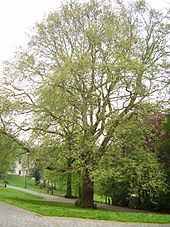Leopoldpark (Brussels)
The Leopold Park is a park in Brussels in the valley of Maelbeek , on the border of the municipality of Etterbeek and at the foot of the European Parliament and the Royal Belgian Institute of Natural Sciences .
The place is a remnant of a medieval complex. Today, hidden behind trees, the tower of Eggevoorde has stood since the 15th century .
geography
The Leopold Park is about 6.4 hectares and is located in the south of the European Quarter of Brussels, just east of the Espace Léopold . Its opening times are from 7 a.m. to 9 p.m. from October 1 to March 31 and 6 a.m. to 10 p.m. from April 1 to September 30.
history
The history of this park began in 1851 when the area assigned to the Société Royale de Zoologie d'Horticulture et d'Agrement was turned into an animal park (the Brussels Zoological Garden ). The park, designed in the style of English gardens , was also used for outdoor festivals and concerts at the time. Even an ice rink, exotic animals, greenhouses and other curiosities could be admired there.
1854 designed Alphonse Balat , the court architect of Leopold II , a small winter garden , a Victoria amazonica , a huge aquatic plant of the Amazon - Rainforest accommodate.
In 1877 the park was transferred to the city of Brussels and renamed Leopold Park on the occasion of the 50th anniversary of independence .
The natural history collections were housed in the old monastery. The museum has been expanded several times in the following years, in 1905 a new wing was built to the Iguanodon , which in Bernissart were discovered to accommodate.
In 1891, in collaboration between the city council and the Université Libre de Bruxelles , the Cité de la Science was founded with the financial support of industrialists such as Ernest Solvay . These include the buildings of the Institute for Sociology ( Solvay Library ), the Institute for Physiology, the Institute for Anatomy and the Institute for Dentistry as well as the vocational school. These buildings make the park an interesting architectural place. The most famous is in the eclectic style built former Solvay library, which opened in 1902, with Art Nouveau - interior was equipped.
In 1919 the university moved to the Solbosch campus . In 1930 the Lycée Emile Jacqmain moved into the former Institute for Physiology.
The other buildings are now used by museums or by the European Union .
In the park there are some trees of great value including an impressive Oriental plane , the only one of its kind in Brussels. The pond and the banks of Maelbeek are inhabited by wild ducks , herons , moorhens , Egyptian geese and parakeets .
Picture gallery
additional
- House of European History in Leopold Park
Web links
Coordinates: 50 ° 50 ′ 18 ″ N , 4 ° 22 ′ 48 ″ E






